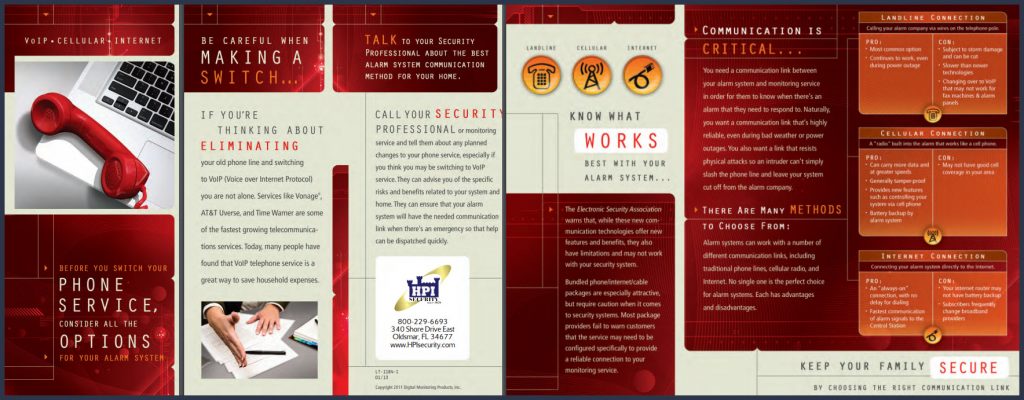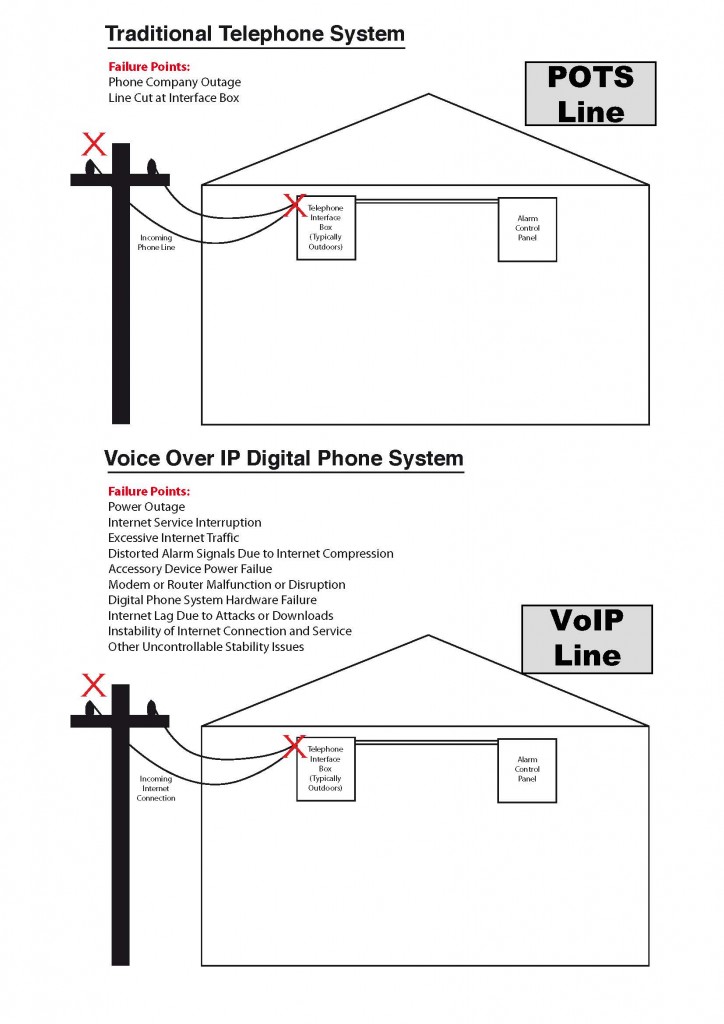Alarm Communications
Many security systems depend on plain old telephone service (POTS) analog telephone lines to connect to the monitoring center. But many telephone service providers (especially new providers like Cable companies) are pushing their customers to convert to, or only provide the cheaper, voice over internet protocol (VoIP) telephone service. VoIP telephone lines don’t work well with alarm communicators. If the alarm signal even reaches the central station, it does so after many tries, wasting precious seconds and minutes in an emergency situation. The HPI solution for the past 30+ years has been to provide wireless communications at a third the cost of keeping your POTS lines. And now the cellular networks have taken even wireless alarm communications up a notch with Mobile Apps and remote controls. See http://www.HPIsecurity.com/alarm_com/
The Why of VoIP
Standard alarm communicator signals travel as a “sound” along copper wire, just like the buzzing noise of a fax machine or dial-up modem. VoIP (Voice over Internet Protocol) is more like a broadband connection; your voice is converted into digital data at your home and “streamed” over your Internet connection to the listener at the other end. Each VoIP provider uses slightly different technology to accomplish this, not all of which are compatible with every security system. The signal sent out by your VoIP service may not be recognized by the monitoring center as an alarm signal.
VoIP service is much different than classic POTS land lines in that it routes all phone traffic through a digital converter, then over the internet. When compared with a POTS line, new concerns are introduced that could affect the stability and dependability of burglar or fire alarm system communication. POTS or, as it is sometimes called, Analog lines are the service available from analogue telephones prior to the introduction of electronic telephone exchanges into the public switched telephone network. These services had been available almost since the introduction of the telephone system in the late 19th century. VoIP is a very new technology and this list will help reduce the possibilities of failure wherever possible by educating the end user and presenting possible solutions.
POTS lines are being phased out by providers and copper lines are being replaced all over the country with fiber optic cabling. And many homes and some businesses are going completely cellular leaving no phone line for the alarm system to communicate over. If you are not yet facing this communications conundrum you soon will be.
(Click on image for full size information brochure) 
VoIP Areas of Concern
1 Power Supply
Problem The VOIP modem can come as a stand-alone network device, or a combination broadband modem/router/and VOIP converter. This raises new concerns for power supply, as regular phone lines are powered from the telephone company. With VoIP, if the power fails during a storm, blackout, or local electrical problem, the security system will be unable to communicate due to no internet phone service.
Solution A backup battery solution must be in place so that the modem can operate under power failure situations. Uninterruptible Power Supplies (UPS) can be purchased from any electronics store, and all network equipment should be protected and placed on battery backup. This includes any routers, modems, any facilities required to be on for the network to function, and the VOIP device as well.
2 Electronics Failure
Problem The VOIP modem, router, any firewall in place, or broadband modem can lock up or lose signal due to buggy or defective hardware. This could result in the loss of internet connectivity or an unresponsive connection. A cable may become unplugged and result in loss of internet connectivity or digital phone service.
Solution All hardware must be replaced if faulty, or different hardware purchased if a connectivity problem continues. All hardware should be checked for operation constantly, and, to minimize the chance of loss of alarm monitoring, should be replaced as soon as possible in the event of failure. All cables should be checked and inspected to verify proper internet and digital phone service operation.
3 Loss of internet connectivity
Problem The modem could lose signal or connectivity to the internet, resulting in loss of digital phone service. This could occur for many reasons, including, but not limited to, internet service provider down-time due to problems or maintenance, storm caused problems or damage, lag-time caused by high internet or local Ethernet traffic, loss of signal due to malicious attacks or network traffic, and the.
Solution Most of the time, these problems are out of control of the digital phone customer, and the dependability of the phone service can be down for minutes, or hours, resulting in no alarm communication. A backup communication route should be explored, the most reliable being the Cellular Backup Service, which relies on the cellular band network and is not affected by VOIP problems such as cut phone wires or loss of internet connectivity. These options should be considered as a reliable backup system in the event that any failure is encountered by the VOIP service.
4 Loss of power to accessory devices
Problem VOIP phone service is often tied into a home’s existing phone wiring for practical purposes. This is done either by connecting the VOIP modem directly to the wiring in newer homes with phone connections and network equipment next to each other inside of a closet. Other times a different approach may be taken to introduce the phone system into the wiring. This can be done using a Wireless Phone System which plug into a regular household outlet, and transmit phone signals to other units that are plugged in the outlets throughout the house. If even one of these phone system transmitters or receivers loses power due to an electrical outage or device failure, this means that the phone service is effectively unavailable and the alarm will not be able to communicate.
Solution Consider Uninterruptible Power Supplies for all accessory devices and be certain to consider each and every device that would require power for the phone system to be operational. Consider contacting your Digital Phone Service provider and asking them which devices should be on battery backup so that you can reduce the chances of phone failure in the event of a power outage.
5 Instability of Digital Phone Service Quality
Problem When HPI connects an alarm to VOIP service, the technician will do everything possible to fully test the alarm signals and program the system for maximum protection against compression artifacts and other problems that could occur while alarm signals are traveling along the digital phone system. However, this does not mean that VOIP service will transmit alarm signals at a 100% success rate. The VOIP system is highly dependent on other factors such as internet traffic, internet hops, lag time, and other concerns which could garble or drop your alarm signals, resulting in no communication to the central station.
Solution This should be kept in mind when purchasing digital phone service as well as the consideration of a backup transmission method, such as Cellular Backup Service. Once the alarm signals are converted into digital signals and are traveling across the internet network, anything may happen to the data to keep it from reaching the central station. Much like a lost email, lost file transmission, or internet connection problem, this could mean that something as urgent and important as a fire alarm or panic alarm would not be received at the central station due to internet routing problems. It is strongly advised to consider Cellular Backup service due to the unstable and uncontrollable factors that could render alarm communications useless.

Conclusion
Placing a battery backup solution, checking and inspecting all equipment, and replacing components as soon as possible if bad are some things that can be done to reduce the probability of failing alarm system communications. However, as described in this article, there are many factors which simply are out of control or non-serviceable for the customer. The VOIP system is a new, emerging technology and is nowhere as dependable as the traditional POTS telephone system, as the new VOIP service is based on a completely new infrastructure. And because there were no standards each of the hundreds of providers have their own protocols making it impossible for alarm digital communicators to be made compatible.
Much care should be taken to protect and preserve what communications exist using digital phone service, however, a backup plan should be highly considered for a system that protects property, and especially for a system that protects life and property by means of police, fire, and medical panic alarms or automatic fire alarm protection.
The HPI Communications Solution
Wireless Cell Communications
The answer is to convert your alarm system to wireless cell alarm communications service. Alarms using cell service to communicate, will make your system more secure from VoIP incompatibility and line cutting attacks, plus it opens you up to a whole new world of mobile App services that were not previously available with the old landline services. And it will allow you to retain your digital VoIP service and benefits with your current provider, while having your alarm system connected to a more reliable, dependable communications network that is fully supervised 24 hours a day and will alert the you to the fact if connectivity is dropped.
Lastly, Cellular Alarm Communications is a third the cost of maintaining the POTS lines otherwise needed for your alarm to work and quickly makes up any upfront investment in communicator upgrades. Cellular communications is the direction the industry and authorities issuing codes and standards has gone.
Contact HPI for fire and security communications cellular solutions today at (800) 229-6693 to upgrade today!





